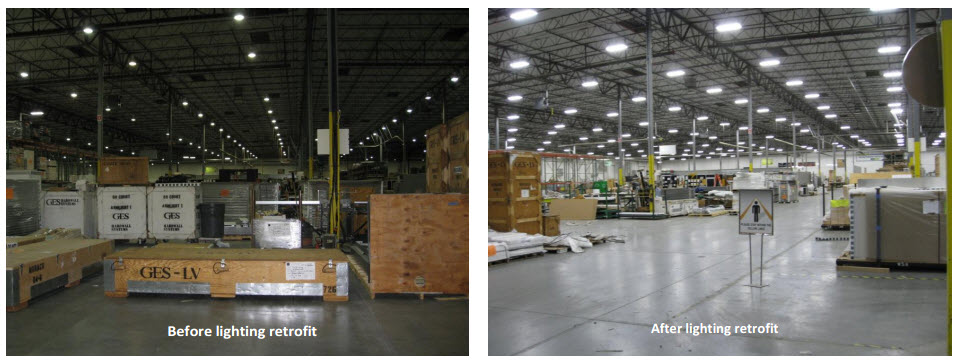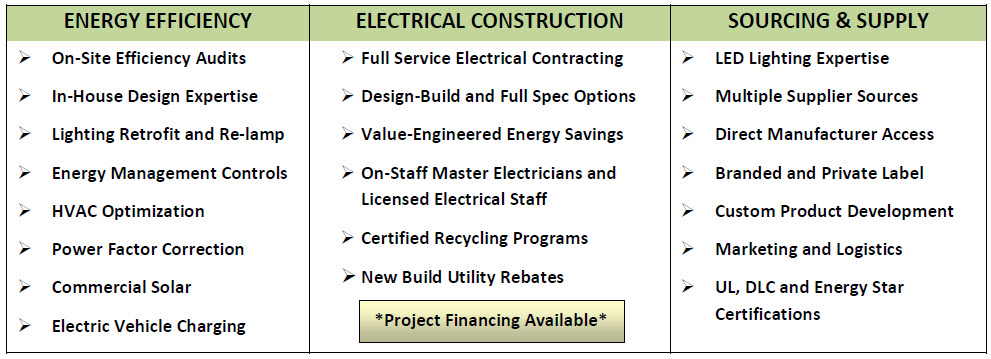
Could changing light fixtures impact property value?
This month, I had the opportunity to sit down with Noble Conservation Solutions, a Turn-key Strategic Partner for Integrated Energy Efficiency Improvements and Services. NCS is headquartered in Plymouth, Minnesota and provides turn-key projects in all 50 states, including: lighting design, tax credit certification, rebate administration, installation and recycling. Throughout my real estate career as an appraiser and investor, I’m constantly searching for ways to help property owners lower operating expenses and enhance property value. This conversation opened my eyes to some of the latest benefits of building energy efficiency analysis.
One of the major operating expenses in all commercial real estate is utility expenses. Common utility expenses include water and sewer, natural gas for heat and electric. Significant progress has been made over the past decade with vastly improved energy efficient solutions. By performing a detailed on-site efficiency audit, NCS provides property owners and tenants a clear path to lower utility and maintenance expenses. If completed, an opportunity may exist to improve cash flow and property value. Examples of their possible solutions include:
 Source: Noble Conservation Solutions
Source: Noble Conservation Solutions
Let’s dive deeper into the latest LED lighting technology and some of the benefits. Currently, most commercial buildings feature some combination of fluorescent light fixtures, metal halide, high-pressure sodium and halogen bulbs.
1. Long Life
In recent years, light-emitting diode (LED) light sources have continued to gain traction and improve quality. LED lamps carry a five year warranty with brands such as Bright Space, Green Creative, TCP, and Philips. Most commercial LEDs have a lifespan of up to 50,000 hours. This is years of use before required replacement and can lower long-term operating costs compared to traditional lighting sources. On average, LED bulbs last 10 to 20 times as long as conventional fluorescent, metal halide, high-pressure sodium and halogen bulbs. Maintenance costs are reduced because with the extended lamp life, fewer labor hours are required for replacements.
2. Energy Efficient
LEDs are extremely energy efficient and may consume up to 90% less power than incandescent bulbs. Since LEDs use only a fraction of the energy of an incandescent light bulb, there is a dramatic decrease in power costs.
LEDs are superior at efficiently converting electrical energy to photons (light) and heat. When compared to traditional lighting and conventional light bulbs, LEDs use about 80% of the electrical energy to convert to light, while only 20% is lost and converted into other forms of energy such as heat. With traditional incandescent light bulbs, which operate at 20% energy efficiency, 80% of the electricity is lost as heat. Example:
If you use traditional lighting and have an electricity bill of e.g US$ 100, then US$ 80 of that money has been used to heat the room, not to light it! Using LED illumination with 80% efficiency, the electricity costs would be around US$ 20 and you’d have saved around US$ 80.
The electrical wattage reduction and efficient use of the energy act as a multiplier to achieve greater energy efficiency. Although LEDs have a higher initial cost than incandescent and compact fluorescent light bulbs, the cost is quickly recouped with much lower electricity costs. During my study of looking at several LED light fixtures compared to standard fluorescents, a big takeaway was how the LEDs shine directly down whereas fluorescents illuminate 360 degrees (up towards the ceiling).
As an example, let’s consider an apartment complex. While most apartment properties have individually metered units for electric, owners must pay for common area lighting such as hallways, underground parking garages (lighting is on 24/7) and outside pole lighting. After the initial investment is paid off (typically less than three years) for installing new LED lighting, the lower utility and ongoing maintenance expenses directly increase the net operating income (NOI). This would lead to greater cash flow and ultimately, increase the property value. NCS reports most lighting retrofit projects have a payback within three years and often can be reduced through various rebates and incentives.
NCS reports that lighting retrofits are perhaps the best short-term practical solution for the majority of businesses-those using existing buildings with older systems. Not only are lighting retrofits at the top of the payback scale, they are also relatively easy, which makes them a practical first step for most businesses. It is also a matter of timing, since tax incentives and rebates being offered now can save businesses up to 60% of their project costs and accelerate savings.
3. Durable Quality
LEDs are extremely durable and are built with components that are highly rugged and can withstand the roughest conditions. LEDs are solid-state lighting devices that utilize semiconductor material instead of a filament or neon gas. An LED light is a tiny chip encapsulated in an epoxy resin enclosure. This makes LEDs far sturdier than traditional incandescent light bulbs or fluorescent tubes.
4. Safety
Improved safety may be one of LED’s most important benefits. LED lights generate virtually no heat. Therefore, they are cool to the touch and can be left on for hours without incident or consequence if touched. LEDs produce 3.4 Btu’s/hour, compared to 85 Btu’s/hour for incandescent bulbs. In comparison, incandescent lighting expels 80 – 90% of the energy it consumes via heat, making the bulbs hot to the touch. LEDs reduce the potential for safety risks such as burns and fires.
ACTION STEP
A simple question to ask is: Is your building equipped with LED lighting? If the answer is no, I recommend considering an energy efficiency audit to determine if a lighting retrofit makes sense. The benefits are what I’ve coined GREEN^2. This is defined as lower energy bills due to reduced energy consumption and lower annual maintenance expense because of fewer light bulb/fixture replacements. With greater net operating income from the real estate, this can equate to an increase in property value.
Are you interested in learning how this may work for you or your clients to improve their property? Contact me today at 612-618-3726 or email mitch@simonsonap.com to learn more.
